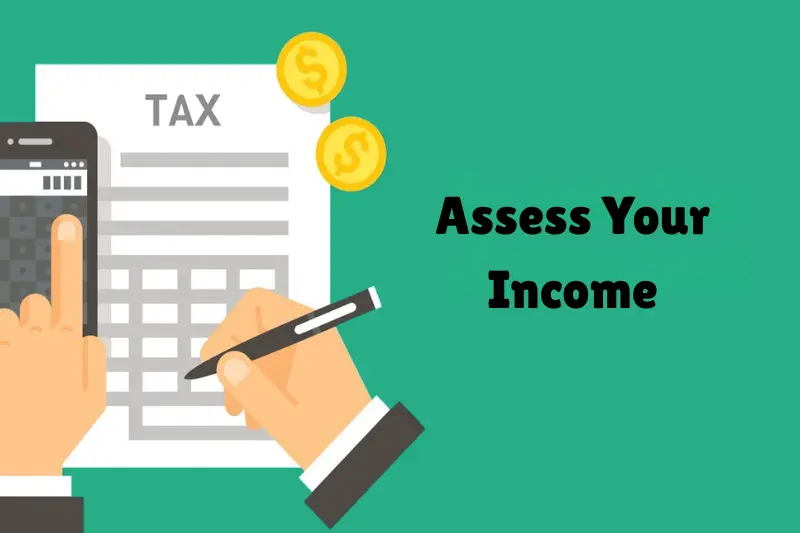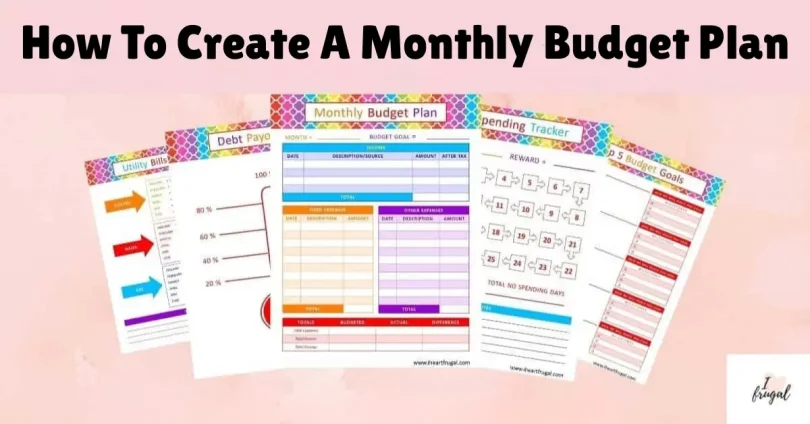Did you know that nearly 6 out of 10 Americans don’t have enough savings to handle a $1,000 emergency, and almost 8 out of 10 struggle with debt? These numbers show just how risky it can be to manage money without a plan.
Imagine this: your car suddenly breaks down, or you have an unexpected medical bill. Without a budget or savings, you might have to rely on credit cards or loans, adding stress and debt. That’s why learning how to create a monthly budget plan is so important—it gives you control over your money, reduces financial stress, and prepares you for life’s surprises.
A smart budget isn’t just about tracking your expenses. It helps you prioritize your spending, save for important goals, and build a safety net for emergencies. Whether your goal is paying off debt, saving for a dream vacation, buying a home, or simply stopping the cycle of living paycheck to paycheck, a well-planned monthly budget is your roadmap to financial security.
Here’s a simple step-by-step guide to get started.
1. Assess Your Income

The foundation of any budget is understanding exactly how much money you have coming in each month. Your income can come from multiple sources, and it’s important to consider them all.
Include all sources of income:
- Salary after taxes: Your net income is what actually hits your bank account, not your gross paycheck.
- Side hustles or freelance work: Income from part-time jobs, gigs, or online work.
- Passive income streams: Investments, rental income, dividends, or royalties.
Once you have a complete list, calculate your total monthly income. This will be the pool of money you will allocate toward spending, savings, and debt repayment.
2. Track Your Expenses
Before you can create a realistic budget, you need to know where your money is currently going. Tracking your spending gives you a clear picture of your financial habits.
Common expense categories include:
- Rent or mortgage payments
- Utilities and bills (electricity, water, internet)
- Groceries and household items
- Transportation (fuel, car payments, public transit)
- Debt payments (credit cards, loans, student loans)
- Entertainment and dining out
- Miscellaneous or irregular expenses (gifts, subscriptions, one-time purchases)
Tips for tracking expenses:
- Use budgeting apps like Mint, YNAB, or PocketGuard for automatic tracking.
- Keep a notebook or spreadsheet to record every purchase.
- Track consistently for at least a month to see patterns.
This step helps identify unnecessary spending and areas where you can cut back.
3. Set Financial Goals
A budget is far more effective when paired with clear financial goals. Goals give you motivation and a reason to stick to your plan.
Types of goals:
- Short-term goals: Less than 1 year (e.g., build a small emergency fund, pay off a credit card).
- Medium-term goals: 1–5 years (e.g., save for a vacation, buy a car).
- Long-term goals: 5+ years (e.g., save for a house, retirement, children’s education).
When setting goals, make them specific, measurable, achievable, relevant, and time-bound (SMART). For example: “Save $3,000 for an emergency fund in 12 months” is much more actionable than “Save money.”
You may also like to read this:
What Is Personal Finance Management: Everything Explained
10 Types of Personal Finance Planning: Complete Guide
Top 10 Reasons Why Saving Money Is Important For Your Future
10 Best Personal Finance Tips For Beginners To Start Saving
4. Allocate Your Income
Now that you know your income, expenses, and goals, it’s time to decide how your money will be spent. A popular guideline is the 50/30/20 rule:
- 50% for needs: Essentials like rent, utilities, groceries, insurance, and minimum debt payments.
- 30% for wants: Dining out, hobbies, entertainment, vacations, and other non-essential spending.
- 20% for savings and debt repayment: Emergency fund contributions, extra debt payments, retirement savings, and investments.
You can adjust these percentages depending on your financial priorities. For example, if you’re paying off a large debt, you might allocate 30% toward debt repayment and reduce spending on wants.
5. Choose a Budgeting Method

Choosing the right method makes budgeting easier and more effective. Here are some popular options:
- Zero-based budgeting: Assign every dollar a purpose. Income minus expenses equals zero. Perfect for people who want complete control.
- Envelope system: Allocate cash for each spending category into separate envelopes. When it’s gone, spending stops. Great for controlling discretionary spending.
- Digital apps: Apps like Mint or YNAB track spending automatically, categorize expenses, and provide visual insights into your financial habits.
Pick a method that suits your personality and lifestyle. The easier it is to follow, the more likely you are to stick to it.
6. Review and Adjust Regularly
A budget is not static. Life changes—raises, new bills, unexpected expenses, or financial goals may require adjustments.
Tips for reviewing your budget:
- Check it weekly or monthly to ensure accuracy.
- Compare actual spending versus planned spending.
- Identify areas for improvement or overspending.
- Adjust allocations if your goals or income change.
Regular reviews ensure your budget remains realistic, flexible, and aligned with your financial goals.
7. Stay Disciplined and Celebrate Wins
Budgeting requires discipline, but progress—no matter how small—deserves recognition.
Celebrate financial wins:
- Paying off a credit card or loan
- Building an emergency fund
- Meeting monthly savings goals
Celebrating milestones keeps motivation high and reinforces good money habits. Remember, budgeting is a marathon, not a sprint.
8. Automate Your Savings and Payments
One of the easiest ways to stick to your budget is automation. By automating your savings and bill payments, you reduce the risk of overspending or forgetting an important payment.
- Set up automatic transfers to your savings or investment accounts each month. Even a small amount adds up over time.
- Automate bill payments for utilities, loans, and credit cards to avoid late fees and interest charges.
- Use apps or bank features to round up purchases and save the change—these micro-savings strategies can boost your emergency fund effortlessly.
Automation removes the temptation to spend what you plan to save and keeps your budget on track with minimal effort.
9. Build an Emergency Fund
Emergencies happen, and they often come without warning. A robust emergency fund protects you from financial stress when unexpected expenses arise.
- Aim to save at least 3–6 months of essential living expenses.
- Keep this fund in a separate, easily accessible account so it’s not tempting to spend on non-emergencies.
- Start small if necessary; even $500–$1,000 can cover minor emergencies and prevent debt accumulation.
An emergency fund is a critical safety net that makes your monthly budget more effective and your financial life more secure.
10. Avoid Common Budgeting Pitfalls
Even the best plans can fail if common mistakes creep in. Here’s what to watch out for:
- Underestimating expenses: Be realistic about your spending, especially irregular costs like car maintenance or medical bills.
- Overly restrictive budgets: Cutting every non-essential expense can make the budget unsustainable. Leave room for small treats.
- Ignoring irregular income: Freelancers and gig workers often have fluctuating income—plan for lean months.
- Not reviewing progress: A budget that isn’t monitored won’t be effective. Regularly track and adjust your plan.
Avoiding these pitfalls increases your chances of sticking to your budget and achieving your financial goals.
11. Use Your Budget as a Decision-Making Tool
A budget isn’t just a list of numbers; it’s a tool to guide your financial decisions.
- When considering a purchase, ask: Does this fit within my budget and align with my goals?
- Use your budget to prioritize spending on what truly matters—like paying off debt, investing in your future, or building experiences.
- Make informed trade-offs. For example, choosing to cook at home instead of dining out could free up money for savings or a bigger financial goal.
Your budget becomes a compass that keeps your financial decisions aligned with your priorities.
12. Reassess Your Goals Periodically
Life changes—new job, moving, family changes, or a major purchase. Periodically reassess your goals and ensure your budget supports them.
- Update your budget when your income or expenses change.
- Reevaluate long-term goals at least annually.
- Celebrate goal milestones and adjust timelines if needed.
Budgeting is dynamic, not static. Flexibility ensures your plan remains realistic and achievable.
Conclusion
Mastering how to create a monthly budget plan is one of the most empowering steps you can take for your financial well-being. A well-crafted budget helps you:
- Gain control over your money
- Reduce financial stress
- Save for emergencies and future goals
- Avoid debt traps
- Make informed financial decisions
Remember, budgeting is a skill—like any skill, it improves with practice. Start small, stay consistent, and adjust as needed. Over time, following a monthly budget plan will not only improve your finances but also give you confidence, security, and peace of mind.
Take the first step today: assess your income, track your expenses, and set your goals. Your future self will thank you.
FAQs: How to Create a Monthly Budget Plan
1. What is a monthly budget plan?
A monthly budget plan is a financial roadmap that outlines your income, expenses, and savings goals for a month. It helps you track where your money is going, control spending, save for emergencies, and achieve both short-term and long-term financial goals.
2. Why is creating a monthly budget plan important?
Creating a monthly budget plan helps you avoid overspending, reduce debt, build savings, and stay financially secure. It also provides clarity, reduces money-related stress, and ensures you can handle unexpected expenses without going into debt.
3. How do I start creating a monthly budget plan?
Start by:
Assessing your total monthly income.
Tracking all your expenses for at least a month.
Setting financial goals (short-term, medium-term, long-term).
Allocating income using a method like the 50/30/20 rule.
Choosing a budgeting method that works for you.
4. What is the 50/30/20 rule in budgeting?
The 50/30/20 rule is a simple guideline for allocating your income:
50% for needs (rent, groceries, bills)
30% for wants (entertainment, hobbies)
20% for savings and debt repayment
You can adjust the percentages based on your priorities and financial goals.
5. What are the best tools for creating a monthly budget plan?
Some popular budgeting tools include:
Apps: Mint, YNAB (You Need a Budget), PocketGuard
Spreadsheets: Microsoft Excel, Google Sheets
Manual tracking: Notebook or envelope system for cash budgeting
Choose a tool that matches your lifestyle and makes tracking easy.





